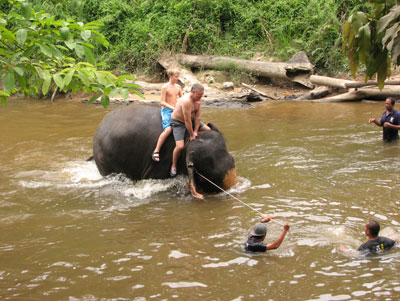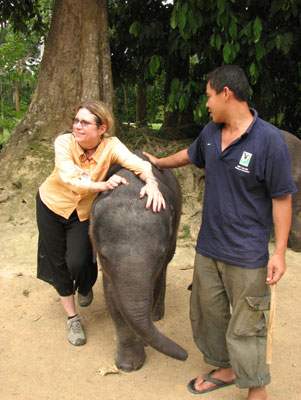Elephant center near Kuala Lumpur
During a short stay in Kuala Lumpur, Malaysia, in March ’07, my travel partner, Frank, and I took a private tour to the Kuala Gandah Elephant Conservation Centre. The reserve cares for homeless elephants and relocates elephants from areas where crops, people or the beasts themselves are at risk.
While in Bangkok preparing to head for Singapore, I found the tour on the Internet offered by Endemic Guides (No. 40, Jalan 8/20, Section 8, 40000 Shah Alam, Selangor, Malaysia; phone +6 03 55123012, www.endemicguides.com), which specializes in travel to nature destinations.
The 9-hour tour out of Kuala Lumpur ran about $65 per person and also visited Deerland Park at the edge of the Krau Forest Reserve. The price included transport from/to our hotel, an English-speaking guide and a light lunch.
Our guide, Lee, was waiting with his car in front of our hotel promptly at 9:15 a.m. and we paid him directly for the tour. As requested, we wore walking shoes and clothes that could get wet in case we swam with the elephants. (Bathing suits are not recommended.)
Lee spoke English well and during the drive told us about his country’s culture and history. Every so often we stopped to see a special orchid, durian fruit, an oil palm tree, etc.
Deerland Park is a privately owned nature area with rusa deer, ostriches, bears, pheasants, pigtail monkeys, rabbits, partridges and more. It seemed we were the only visitors. The sun was bright and we were glad we had worn brimmed hats and sunscreen.
It was a treat to hand-feed fruits and vegetables to some of the animals. I gave a bottle of condensed milk to a young sun bear and his daddy, both of which rolled back in ecstasy to suckle the treat.
At the elephant sanctuary, we learned about the reserve and watched a poignant video. The facility is dedicated to locating, protecting, subduing and relocating problem elephants.
When a problem elephant is reported, trained work elephants assist in the relocation. Using their communal instincts, work elephants flank and then escort the mildly sedated problem elephant out of an area and onto a ferry, which transports the offender to a safer habitat. Hundreds of wild elephants have been successfully moved.
The staff also educates local villagers on how to protect their farms without killing elephants and educates the general public and schoolchildren on habitats and preservation.
The sanctuary houses more than 50 elephants, including some orphaned elephants, from Thailand, India, Myanmar and Malaysia.
Finally the elephants emerged from their mud pools and lumbered, caked in mud, into the roofed holding area, where we were offered an up-close view.
These majestic mammals were smaller in statue and had ears less prominent than those of African elephants. Their long eyelashes surprised me. The camaraderie of the species became clear when I saw them feel for each other’s trunks, as if to comfort one another.
The handlers gave commands in Malay, and the elephants lined up to be bathed, then stood, chained by the ankle to a post, as a soothing power hose sprayed and massaged them.
After the baths, we were allowed to feed them sliced watermelon, bananas and papaya, then we rode them. Afterward, some were led back to their mud holes while others were allowed to go into the nearby river.
One elephant waded into the water with two or three people at a time on his back, then lowered its body to such an angle that the passengers slid off into the brown water as the elephant submerged. We decided to avoid this excitement.
Three orphaned elephants, ages one and two years, made an appearance. My heart melted at the intimate experience of touching them, talking to them and looking into their faces. The trio was led down the river embankment and I could not resist joining them in the water.
The handlers stood watchfully as the babies frolicked, rolled and romped. One baby kept nudging the others, egging them on, coaxing them to play. I wondered if ever again I would behold such an endearing sight.
After the 75-mile drive back to KL, I gave Lee a big tip (about $15), which swept him away. After we returned to the U.S., he e-mailed us photos that he had taken of us without being intrusive in any way. Later he sent a CD of the shots, which I treasure.
Would I recommend this tour? Yes. It enriched our travel a thousand times over and allowed me to appreciate the importance of habitat preservation. Is it a tour for children? Absolutely! Several were present and seemed enthralled.
KIM EDWARDS
Sacramento, CA


